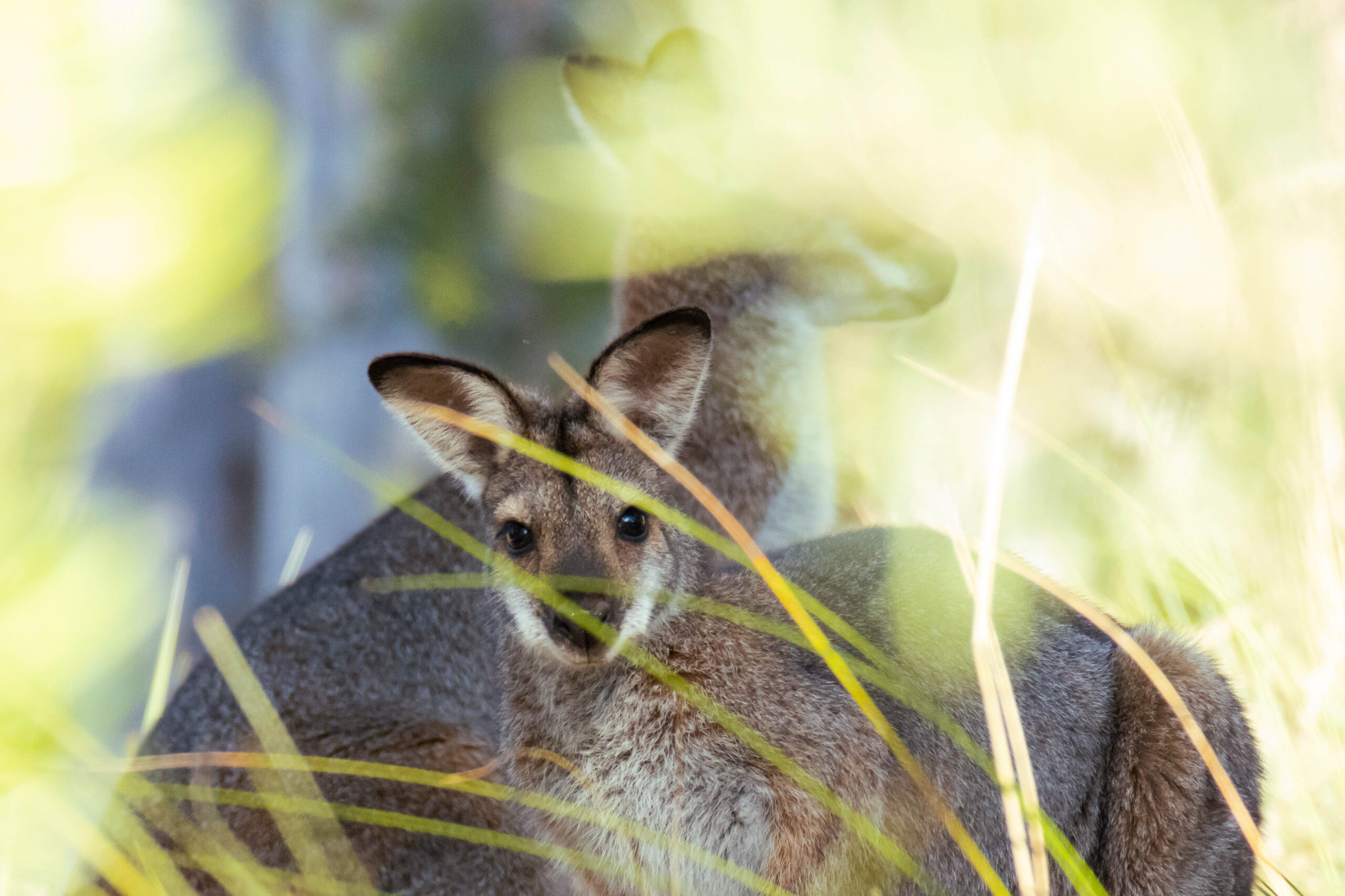In the grassy woodlands and open forests of eastern Australia, the Black-striped Wallaby (Notamacropus dorsalis) moves quietly between cover and open pasture, its distinctive dark dorsal stripe marking it apart from its close relatives. Sometimes called the scrub wallaby, this medium-sized macropod is a creature of both shadow and light, preferring the edges of woodlands where shelter meets feeding ground. Its secretive habits mean it is less familiar to the public than kangaroos or other wallabies, yet it remains an important part of Australia’s faunal identity.
Identification
The Black-striped Wallaby is a medium-sized wallaby, with a head-body length of 70-85 cm and a tail length of 65-75 cm. Adults weigh between 15-25 kg, with males typically larger than females. Its fur is a soft grey-brown with a paler underside, but its most distinguishing feature is the prominent black stripe running along the back from the head to the tail base. It also has a darker facial stripe and pale cheek markings. Its body is compact and muscular, built for agility in dense cover, while the tail is strong and used for balance when hopping.
Habitat and Distribution
Notamacropus dorsalis inhabits a broad but fragmented range along eastern Australia, from northern Queensland through New South Wales to northeastern Victoria. It is most often associated with dry sclerophyll forests, grassy woodlands and forest edges, where it shelters during the day and grazes in open areas at night. Unlike kangaroos, it avoids large open plains, instead preferring mosaics of woodland and grassland that provide both cover and forage.
Ecological Role
As a herbivore, the Black-striped Wallaby grazes primarily on grasses and herbs, but will also browse on shrubs and young shoots. Its foraging helps shape understorey vegetation and contributes to nutrient cycling in woodland ecosystems. It is prey for dingoes, wedge-tailed eagles and introduced predators such as foxes. By occupying woodland-edge habitats, it bridges ecological roles between forest-dwelling wallabies and open-country kangaroos.
Behaviour and Reproduction
Black-striped Wallabies are shy and nocturnal, generally emerging at dusk to feed. They are usually solitary or occur in small groups, though temporary aggregations may form in areas with abundant food. When disturbed, they retreat quickly into dense vegetation.
Breeding can occur year-round, though peaks are seen in warmer months. Females typically produce a single joey after a gestation of around 30 days. The joey remains in the pouch for about 7-8 months, followed by continued suckling until around 12 months of age. As with other macropods, females can exhibit embryonic diapause, pausing the development of a second embryo until the pouch is free.
Conservation Status
In Queensland, the Black-striped Wallaby is listed as Least Concern under the Nature Conservation Act 1992, as it remains relatively common across much of its northern and central range. Populations in New South Wales and Victoria are more fragmented and are monitored closely, though not formally listed as threatened.
Threats
Habitat clearing for agriculture and urban development remains the greatest threat to this species, reducing the woodland-grassland mosaics it depends upon. Vehicle collisions are frequent in regions where wallabies move between fragmented habitats. Predation by foxes and dogs affects juveniles and competition with livestock for pasture reduces food availability in some areas. While not currently threatened at a species level, local declines are evident in southern parts of its range.
Conservation Efforts
The species occurs in many conservation reserves and national parks across Queensland, New South Wales and Victoria, which provide important refuges. Habitat management that retains woodland edges and understorey vegetation is essential for supporting populations. Predator control and community awareness programs assist in reducing pressure from invasive species and road mortality. Continued monitoring helps track changes in distribution and abundance, particularly in fragmented southern habitats.
Final Thoughts
The Black-striped Wallaby is a quiet dweller of the woodland edge – elusive, resilient and beautifully marked with its namesake stripe. Though not threatened at present, its reliance on intact woodland–grassland mosaics makes it vulnerable to the ongoing impacts of land clearing and fragmentation. Protecting Notamacropus dorsalis is not just about safeguarding a single species but about maintaining the balance of Australia’s eastern forests and the delicate interplay between cover and open ground.
Fauna Resources specialises in the safe handling of a range of different fauna species, through safe, effective and ethical fauna solutions. By providing dedicated fauna services, through passionate fauna spotter catchers and fauna specialists, we can support the unique terrestrial ecosystems and rich biodiversity Australia has to offer.
For more information about our specialist fauna services contact Fauna Resources today.
